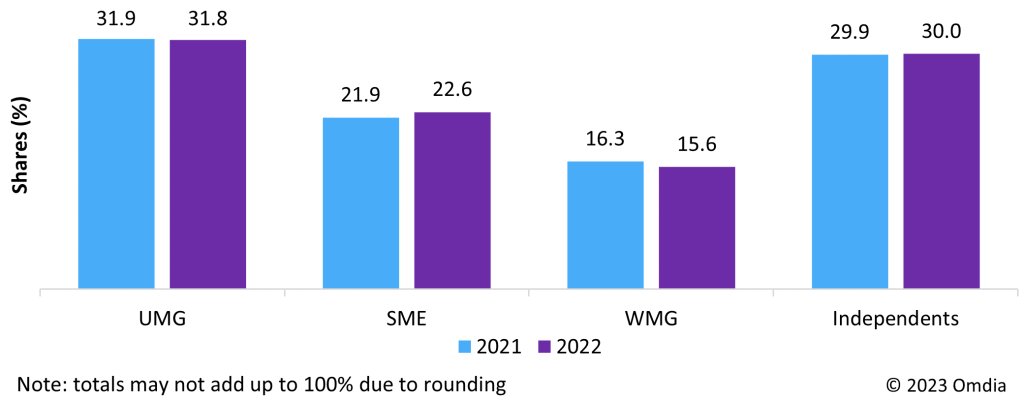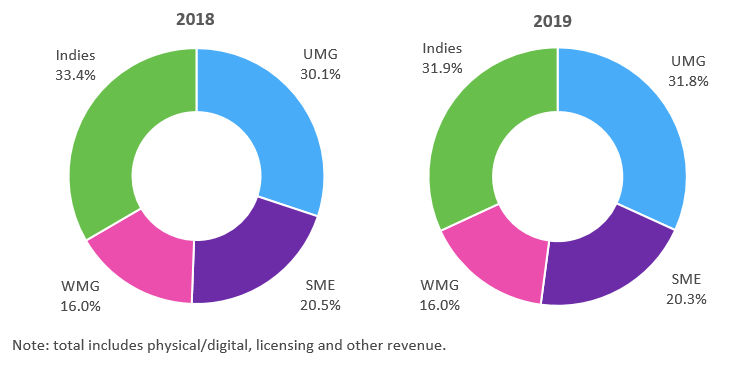Music & Copyright’s annual survey of the recorded-music and music publishing sectors has revealed the changes in global market share for the three major music groups and the independent sector. According to the survey, UMG remained the top company for combined physical and digital recorded-music trade revenue last year, although the company’s share edged down slightly to 31.9% from 32% in 2021 (see Figure 1). For digital revenue only, UMG’s share slipped to 33% from 33.3%, while its physical share increased to 27.6% from 26.8%. The shares are based on revenue received by each company/grouping.
Figure 1: Record companies, physical- and digital-revenue market shares, 2021 and 2022

Source: Music & Copyright
SME enhanced its position as the second-largest record company. Its combined digital/physical market share increased for the fourth consecutive year, ending 2022 at 22.1% compared with 21.7% in 2021. SME’s digital share grew to 23.2% from 22.6%, while its physical share was down to 17.7% from 18.5%. SME’s share of all recorded-music trade revenue, which includes licensing and other revenue as well as income from physical and digital music sales, increased to 22.6% from 21.9% (see Figure 2).
Figure 2: Record companies, total recorded-music-revenue market shares, 2021 and 2022

Source: Music & Copyright
The smaller of the three majors, WMG, suffered a dip in share for both digital and physical sales. According to Music & Copyright, WMG’s digital share was down last year, to 17.2% from 18.2% in 2021. The company’s share for physical sales fell to 10.9% from 11.4%. Of the three majors, WMG had the biggest difference between its digital and physical shares—6.3 percentage points compared with 5.4 points for UMG and 5.5 points for SME.
Collectively, the independents held the biggest share of physical formats. Moreover, the share was up last year, to 43.7% from 43.2% in 2021. Also, the independents’ digital share increased to 26.5% from 25.9%. The results meant the combined digital/physical revenue share for independent companies grew to 30% from 29.5%.
Little change in music publishing shares
In line with the way Music & Copyright determines global recorded-music market shares, music publishing shares are also based on revenue received by each company. Music & Copyright has calculated that global music publishing revenue increased 17.7% last year, to $8.1bn from $6.9bn in 2021. The growth rate was marginally higher than the 17.6% rise in 2021 but more than three times the 5.2% growth in 2020. Although Sony maintained its leading position ahead of UMPG, the gap between the two narrowed to 1.3 percentage points from 1.7 points in 2021. Sony’s share, which consists of revenue from Sony Music Publishing (rebranded from Sony/ATV in early 2021), EMI Music Publishing (EMI MP), and Sony Music Publishing Japan, edged down to 24.7% from 24.9% (see Figure 3).
Figure 3: Music-publishing companies, revenue market shares, 2021 and 2022

Source: Music & Copyright
UMPG’s publishing share grew last year, to 23.4% from 23.2% in 2021. Third-placed WCM registered the second consecutive annual rise in share. Music & Copyright estimates the company’s share increased to 12% from 11.8%. Although the collective share of independent music publishers maintained a healthy lead, the share slipped slightly last year, to 40% from 40.1%.
If you would like more information about the newsletter or to set up a subscription, then send us an email Alternatively, if you would like to download a sample copy, just go here.
 The latest issue of Music & Copyright is now available for subscribers to download. Here are some of the highlights.
The latest issue of Music & Copyright is now available for subscribers to download. Here are some of the highlights. The latest issue of Music & Copyright is now available for subscribers to download. Here are some of the highlights.
The latest issue of Music & Copyright is now available for subscribers to download. Here are some of the highlights. Source: Music & Copyright
Source: Music & Copyright Source: Music & Copyright
Source: Music & Copyright Source: Music & Copyright
Source: Music & Copyright Source: Music & Copyright
Source: Music & Copyright  Source: Music & Copyright
Source: Music & Copyright  Source: Music & Copyright
Source: Music & Copyright 



You must be logged in to post a comment.